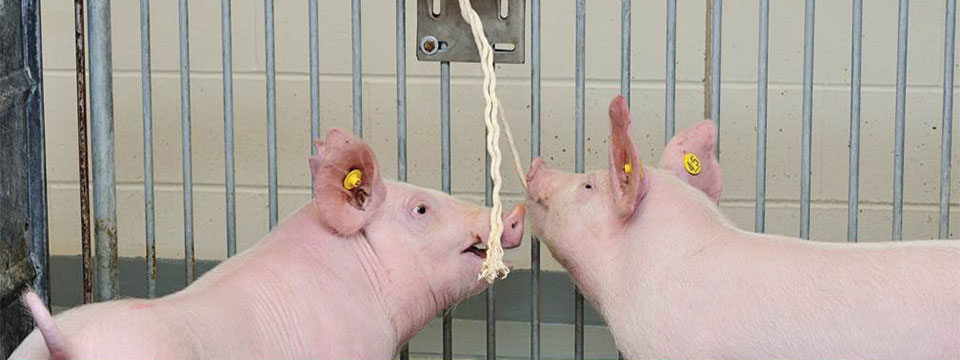
Dr. Jeffrey Zimmerman, professor at the Iowa State University’s Veterinary Diagnostic Laboratory, has a clear memory of when he came up with an idea that has transformed diagnostic medicine in the pig industry.
In February 2005, Zimmerman and his research team were conducting a study of porcine reproductive and respiratory syndrome virus (PRRSV). PRRSV causes reproductive failure in breeding stock and respiratory tract illness in young pigs and is one of the most costly diseases of swine in Iowa and the U.S.
Zimmerman and his team were attempting to determine how long the virus continued to replicate in pigs, which localizes in tonsil tissue. The original plan was to collect “tonsil scrapings” - a well-established procedure. But the plan was not working out because there were too many pigs (150) and too few people.
The solution? Zimmerman came up with the idea of collecting oral fluids by hanging a rope in the pen.
“They were like flies on honey,” he said. “They loved chewing on the rope and left plenty of oral fluid in the process. We quickly collected the samples we needed for testing and were able to find both PRRSV antibody and nucleic acid - a diagnostic success.”
As this research has moved forward over the ensuing years, Zimmerman and his team have found that oral fluids are a great diagnostic specimen for PCV2, influenza, PEDV, PRRSV, and a variety of other pathogens, including important “exotic” pathogens like African swine fever and foot-and-mouth viruses.
Today, oral fluid testing is done not only throughout the United States, but also in Europe, South American, and Asia. Collecting herd health information on a variety of pathogens using an oral fluid sample is simple and cheap, so it has caught on with pork producers and pig veterinarians.
Zimmerman does not have worldwide figures, but he can cite figures for Iowa State’s Veterinary Diagnostic Laboratory. In 2010, the first year oral fluid testing for PRRSV was offered, the Iowa State VDL tested 10,000 oral fluid samples. Moving forward five years, more than 175,000 samples were tested at the ISU VDL. Zimmerman estimates those tests are equivalent to testing 4.4 million pigs through the Iowa State VDL alone.
One of the reasons for this may be the cost savings the pork industry is experiencing with oral fluid-based testing. The cost of monitoring a 2000-head finishing barn using six oral fluid samples is just 3 cents per pig. Put that cost against the estimated cost of PRRSV in growing pigs ($5 to $15 per pig marketed) and the rationale for more monitoring using cost-efficient sampling methods is obvious.
Zimmerman will be recognized for his game-changing research this fall with Iowa State University's top research award - the ISU Award for Outstanding Achievement in Research. He will be one of two Iowa State professors so honored this year.
Zimmerman’s oral fluids research has been funded in part by the Iowa Pork Producers Association and the National Pork Board.
September 2017
